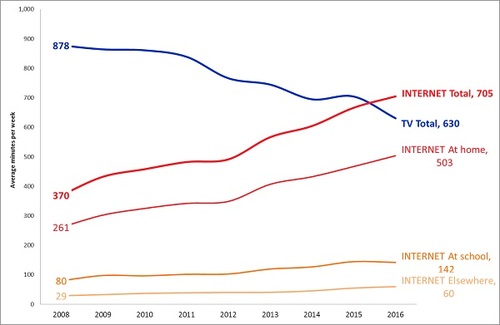|
|
|
Contributors | Messages | Polls | Resources |
|
Aussie Kids Trading TV Time for Internet A new survey from research company Roy Morgan found that Australian children aged 6-13 spend an average of just under 12 hours (705 minutes) every week using the Internet. That's an astonishing leap from the average in 2008: Just eight years ago, Australian children were spending closer to half that time -- a mere six and a half hours per week -- on the Internet. This is noteworthy because the TV dominates -- by a large margin -- the average time spent on media per day across most demographic groups and surveys. Time spent is declining, mostly driven by a shift to mobile devices, but TV viewing still consistently dwarfs every other medium. As you would expect, this increase in Internet usage has come at the expense of television. In 2008, the average Australian in this age group spent more than 14.5 hours watching TV per week. This has declined to 10.5 hours (630 minutes), with time spent online outpacing TV viewing for the first time in 2016.
Australian Kids Spending More Time Online Than Watching TV

Source: Roy Morgan Young Australians Survey Fielded January 2007 to December 2016 Average annual sample = 3,150 Australians aged 6 to 13 That's not a lot though, and at the current rate that gap is likely to close soon. The findings of this survey suggest that a new generation is unlikely to be interested in traditional television, and will further accelerate cord-cutting behaviors we are already seeing around the world. That is certainly a possibility, but I would also consider two arguments to the contrary. Firstly, the type of usage behavior, preferred content genres and daily schedule followed by those aged under 13 will likely change as they grow older. And those changes will influence their platform and activity preferences as well. So the shift from TV to Internet may actually reverse as this generation grows up. Second, the definition of TV itself is starting to get murky. Watching content on your TV doesn't necessarily mean you aren't on the Internet. SmartTVs, USB dongles/sticks and OTT set-top boxes now make it fairly simple to get Internet content on your TV screen. So in this scenario, are you online, or are you watching TV? We do see a preference for a lean-back experience when watching TV as we move up age groups. But is that a behavior established due to years of viewing TV when the web didn't exist, or is it primarily influenced by lifestyle and schedule? I suspect it will be some of both, but we'll only know for sure when these kids grow up. — Aditya Kishore, Practice Leader, Video Transformation, Telco Transformation |
Contentious issues that are likely to fuel lawsuits and angry blogs in the coming year.
Content producers are unhappy with the advertising approach and revenues they are getting on Facebook Watch.
OTT video usage is driving the penetration of various Internet connected devices to help view online streams on the larger TV screen.
Major Hollywood studio to trial 'virtual' movie theaters using head-mounted displays.
Network technology vendor Sandvine has found that piracy isn't only hurting network operator profits – each pirated set-top box is also using up 1TB per month in 'phantom bandwidth.'
 On-the-Air Thursdays Digital Audio On-the-Air Thursdays Digital AudioARCHIVED | December 7, 2017, 12pm EST
Orange has been one of the leading proponents of SDN and NFV. In this Telco Transformation radio show, Orange's John Isch provides some perspective on his company's NFV/SDN journey.
 Special Huawei Video Special Huawei VideoHuawei Network Transformation Seminar The adoption of virtualization technology and cloud architectures by telecom network operators is now well underway but there is still a long way to go before the transition to an era of Network Functions Cloudification (NFC) is complete. |
|
|
|
||


















